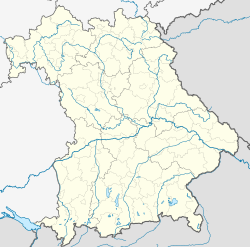Bayerisch Eisenstein
Bayerisch Eisenstein | |
|---|---|
 Train station | |
| Coordinates: 49°7′12″N 13°12′00″E / 49.12000°N 13.20000°E | |
| Country | Germany |
| State | Bavaria |
| Admin. region | Niederbayern |
| District | Regen |
| Subdivisions | 8 districts |
| Government | |
| • Mayor (2020–26) | Michael Herzog[1] (CSU) |
| Area | |
| • Total | 47.34 km2 (18.28 sq mi) |
| Elevation | 724 m (2,375 ft) |
| Population (2022-12-31)[2] | |
| • Total | 993 |
| • Density | 21/km2 (54/sq mi) |
| Time zone | UTC+01:00 (CET) |
| • Summer (DST) | UTC+02:00 (CEST) |
| Postal codes | 94252 |
| Dialling codes | 09925 |
| Vehicle registration | REG |
| Website | www.bayerisch-eisenstein.de |
Bayerisch Eisenstein, until 1951 just Eisenstein (Czech: Bavorská Železná Ruda) is a village and a municipality in Regen, in Bavaria, Germany.
Geography[change | change source]
Bayerisch Eisenstein is part of Bayerischer Wald and borders the first German national park established in 1968.
It is one of three connected places in the area. The other two are Železná Ruda (German: Böhmisch Eisenstein or Markt Eisenstein) and Špičák (German: Dorf Eisenstein), both in Czech Republic. Železná Ruda is 2 kilometres northeast from Bayerisch Eisenstein. The town's railway station is split by the border. In August 2006 Bayerisch Eisenstein and Železná Ruda signed a twinning agreement
References[change | change source]
- ↑ Liste der ersten Bürgermeister/Oberbürgermeister in kreisangehörigen Gemeinden, Bayerisches Landesamt für Statistik, 15 July 2021.
- ↑ Genesis Online-Datenbank des Bayerischen Landesamtes für Statistik Tabelle 12411-003r Fortschreibung des Bevölkerungsstandes: Gemeinden, Stichtag (Einwohnerzahlen auf Grundlage des Zensus 2011) (Hilfe dazu).
Other websites[change | change source]
- Official website
 (in German)
(in German)





